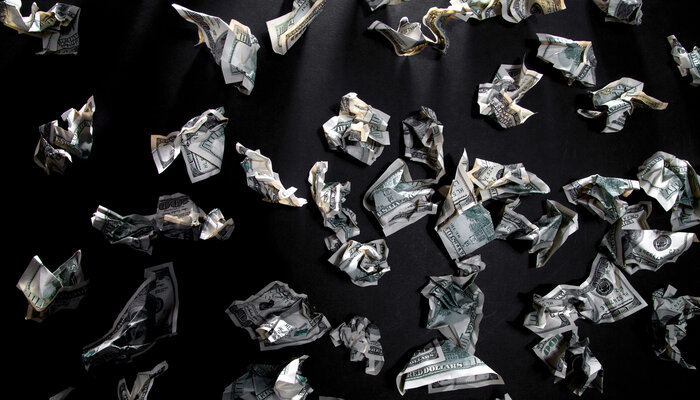The 2020 federal elections included at least $100 million in the spending of dark money, which hides its true funders.
As I detailed here, 2020 will eventually be in the Guinness World Records as the most expensive election ever. The previous winner was Obama’s reelection campaign in 2012. That race was a standout for another reason: it featured the most dark money spent in any federal election then or since. (Pro Publica has a good data visualization of how this happened in 2012.)
Dark money becomes dark by being routed through opaque nonprofits, including 501(c)(4) social welfare organizations and 501(c)(6) trade associations. Then the nonprofit buys political ads trashing or touting a particular candidate. The ads will only be traceable to the last organization who spent the money, so the public can’t see who paid the front group. Since 2008, over $1 billion in dark money has been spent.
Dark money has grabbed the biggest headlines in federal elections, but the same problem pops up in state elections too. If you would like to learn more, there’s a great documentary about dark money in Montana’s state elections —fittingly called Dark Money — that explains how this problem can infect state and local races as well.
In the last presidential election in 2016, the National Rifle Association (NRA) made waves being the biggest dark money spender, spending $54 million. If you’d like to learn more about that, there’s a new documentary called Fish in Barrel by filmmaker John Wellington Ennis that explains what the NRA was doing with that money. In 2020, the organization spent a more modest $23 million, half of which went to running ads against Joe Biden.
There was $100 million in dark money reported to the Federal Election Commission, which is trending downwards compared with previous presidential election years. The bad news is that this figure likely underreports the problem by over 600 percent. According to Open Secrets and the Wesleyan Media Project, dark money groups have poured more than $750 million into 2020 elections through ad spending and record-breaking contributions to political committees such as super PACs. They get their figures by looking at ad buys during the election. This could mean that $650 million is what I call “black hole money” — money spent on politics and never reported in the campaign finance system.
One way the spending of black hole money happens is if a group spends money on ads more than 60 days out from an election that lacks words of “express advocacy.” According to the Wesleyan Media Project, this type of spending happened a lot in 2020, to the tune of $144 million. Another black hole money pit is online ads, which largely go unreported. There were $26 million worth of political ads on Google and Facebook alone.
Democratic-leaning dark money groups outspent their conservative counterparts in 2020. In terms of on-the-record dark money reported to the FEC, the two biggest spenders were the liberal group Defending Democracy Together ($15 million) and the National Association of Realtors Super PAC ($13 million). But this spending was dwarfed by more convoluted spending by the liberal Sixteen Thirty Fund, which spent $51 million, and one of its beneficiaries was the Lincoln Project.
Two actions from the Trump administration are likely to make dark money even darker in the coming years — provided that these actions are not undone by the incoming Biden administration. One is that the IRS no longer requires 501(c)(4)s and 501(c)(6)s to disclose their underlying donors.
The other is a set of rule changes by the Securities and Exchange Commission that make it harder for shareholders to hold companies accountable for a company’s political spending. These changes imposed heightened eligibility requirements for submitting a shareholder proposal, restricted a person to only one proposal per meeting, and increased the resubmissions thresholds for shareholder proposals.
The SEC replaced an easy-to-meet $2,000 threshold of stock ownership for proposals with a tiered approach based on a combination of position size up to $25,000 and holding period up to three years. These new thresholds will limit entry to large investors or long-term investors.
These changes in securities laws impact the fight over dark money because over the past decade, investors used the previous shareholder rules to ask public companies to stop being the sources of dark money. Many public companies, at least 173, bowed to this pressure and became more transparent. The new SEC rules make it harder for investors — the true owners of a company — to pressure inside managers to be better on the dark money issue.
Actions from Senate Majority Leader Mitch McConnell have also contributed to the persistence of dark money. He’s once again placed a rider into the budget bills that are needed to keep the government running after December 11 that stop the SEC from making any anti-dark money rules.
Meanwhile, control of the Senate is still up for grabs with two seats from Georgia to be decided in runoff elections in January. Those elections may make these the most expensive Senate seats ever. One thing to keep an eye on is how much of that spending is done with dark money. According to Open Secrets, Georgia’s Senate race in 2020 had more than $3.1 million in direct dark money spending reported to the FEC, which was more than any other congressional election.
All of this points to one conclusion: trying to tackle the dark money problem should be a priority for the incoming Biden administration.
The views expressed are the author’s own and not necessarily those of the Brennan Center.



